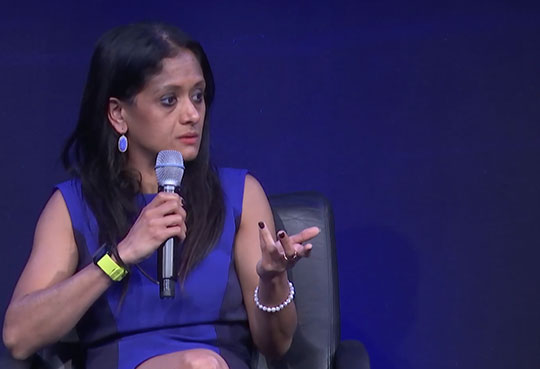 Image shows BCG’s Sreelakshmi (Sita) Sonty speaking at the Satellite Innovation 2022 in Mountainview, Calif. In an interview with Constellations, Sonty discussed trends driving the commercial space sector.
Image shows BCG’s Sreelakshmi (Sita) Sonty speaking at the Satellite Innovation 2022 in Mountainview, Calif. In an interview with Constellations, Sonty discussed trends driving the commercial space sector.
ALEXANDRIA, Va. — The next few years will see an unprecedented growth of non-geostationary orbit (NGSO) constellations providing new capabilities for the terrestrial economy and new opportunities for value-added space services.
Sreelakshmi (Sita) Sonty, Partner and Associate Director of Aerospace for Boston Consulting Group (BCG), tracks trends across the commercial space value chain. In an interview with Constellations, she noted an acceleration in terrestrial organizations’ use of space and how that is impacting the way space service providers are delivering solutions, particularly within the ground segment.
“What we’re seeing now is a fundamental inflection point in the terrestrial economy,” Sonty said. “The terrestrial economy is now aware that you can achieve greater precision agriculture solutions with satcom. You can achieve reduced carbon emissions from your plant with Earth observation. You can have more effective delivery services with position, navigation and timing. These are all terrestrial economy solutions. And we’re seeing that space is becoming just a fundamental part of their supply chain.”
More significant, these terrestrial use cases are not hypothetical. They’re supported by meaningful procurement by customers, changes in service delivery models by vendors and a larger portion of private or commercial finance.
After the aerospace investment firm AE Industrial Partners bought a majority stake in the smallsat manufacturer York Space, York Chairman Charles Beames suggested the deal was characteristic of the trend to view space as a routine part of a business. In an interview with Bloomberg Law, Beames anticipated that in the next five years, “Fortune 100 companies are going to look at the space part of the company a lot like the way they look at IT today.”
Growth in Value-Added Services
On the supply side, commoditized launch services continue driving down the cost of putting mass on orbit, which has raised the question of where the industry will see a subsequent rise in demand.
“That demand is in value-added services,” Sonty asserted, referring to space-based services that unlock increased capabilities and value for the end user. Specifically, she pointed to commercial satcom and Earth observation as value-added services with the greatest growth potential.
John Deere’s announcement in late September that it was seeking satcom solutions to connect 1.5 million of its smart machines was typical of this trend. The agriculture sector was an earlier adopter of satellite services and continues expanding its use of space through Earth observation data and AI/ML-enhanced analytics to enhance crop yields as well as satcom for remote communication and automation.
 John Deere’s September request for satcom solutions for its autonomous vehicle fleet shows the expansion of value-added satellite services for precision agriculture. (Source: USDA)
John Deere’s September request for satcom solutions for its autonomous vehicle fleet shows the expansion of value-added satellite services for precision agriculture. (Source: USDA)
Oil and natural gas companies have also continued deepening their space ties beyond the traditional applications of satcom and remote sensing. Saudi Aramco has incorporated satellite technology in its investment strategy. Aramco’s venture capital arm recently led a $13 million funding round for OQ Technology, a satellite IoT company looking to provide sensor technology to track and monitor rigs, pipelines and other assets.
Local governments, NGOs, nonprofits and corporations are another relatively unaddressed customer base for both satcom connectivity and Earth observation insights for land management, urban development and regulatory and environmental compliance.
The integration of satellite and terrestrial telecommunications networks is one of the most undeniable trends, evidenced by new partnerships and major distribution agreements as well as 3GPP Release 17, which supports 5G standards for non-terrestrial networks.
“It’s not a slow burn,” Sonty said. “There’s real momentum, not just behind terrestrial networks looking at satcom and moving away from perceiving satcom as competition, but towards terrestrial networks looking at satcom and saying we need to partner--and the same in reverse.”
Digital Ground as an Enabler
The inclusion of space as a value-added service has allowed end users across sectors to execute higher level task performance with greater precision and problem solve in real-time. Those services remain dependent on ground segment capable of economies of scale and adapting to new service applications.
 Earth observation and satcom services are unlocking greater value for the terrestrial economy. (Source: NOAA)
Earth observation and satcom services are unlocking greater value for the terrestrial economy. (Source: NOAA)
Because of recent innovations in digitization and software-defined networks, the ground segment has become an area of both market change and growing investor interest, according to Sonty.
Software-defined and digital ground networks can scale rapidly to meet addressable market demand and the expansion into edge computing, cloud-based ground networks promise to lower the cost of deploying, operating and using ground services over time.
“That’s obviously catnip for investors,” Sonty noted.
The shift from hardware to software solutions has paved the way for more partnerships between cloud companies and satellite service providers while stimulating vendors to invest in innovative ground solutions.
Over the past year, Intelsat has invested $2 billion into software-defined space and ground networks and established digital ground as a central part of its network evolution. Other leading satellite operators and satcom providers are also moving ahead with software-defined ground networks.
Sonty noted that legacy players in ground solutions are “catching up in innovation” as government, defense and commercial customers demand dynamic, scalable solutions. “If customers are pushing on those levers, then that’s absolutely going to drive what the vendors do.”
Explore More:
Podcast: 5G, Satellites and Connectivity Anywhere
Globalstar Chairman: Our Agreement with Apple Starts this Autumn
Satellite Moving Closer to Telcos with Ground Virtualization, 5G
How Does Satcom Go Beyond Apple/Globalstar?
